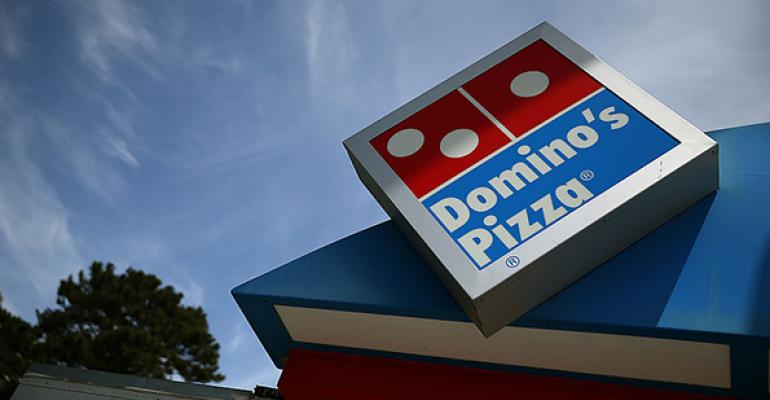Domino’s Pizza Inc. stock has been on an almost unstoppable upward trajectory since late 2008 due to the chain’s consistent growth in sales and profits.
But executives found themselves on the defensive Thursday despite a first-quarter earnings report in which same-store sales rose 6.4 percent in the U.S. — the company’s 20th consecutive quarter of growth — and two-year same-store sales growth of more than 20 percent.
Domino’s stock fell more than 8 percent in Thursday morning trading because earnings growth didn’t meet Wall Street expectations. In the quarter ended March 27, net income fell 1.8 percent, to $45.5 million, or 89 cents per share, from $46.3 million, or 81 cents per share, a year ago.
“We’re building the brand the right way,” Domino’s CFO Jeffrey Lawrence said during an earnings call Thursday. “Earnings will fall where they may. But we feel good about our long-term financial engine.”
Domino’s CEO Patrick Doyle said: “Our two-year [same-store sales] has been north of 20 percent for two straight quarters. I don’t believe we’ve ever done that. Our domestic momentum is as good as it’s ever been.”
Domino’s added 162 locations in the first quarter, and has nearly 12,700 units worldwide. In the U.S., the chain added 16 units, bringing it to 5,216 locations. Revenue in the quarter rose 7.4 percent, to $539.2 million, from $502 million in the same period a year ago.
Internationally, the chain continued to roll in the quarter. Same-store sales increased 7.9 percent outside the U.S. — the 89th straight quarter of international same-store sales growth.
Still, Domino’s domestic performance has been key for the company’s stock growth, which has gone from a penny stock to one of the strongest performers on Wall Street in just eight years.
Most recently, the chain’s sales have been driven by its relentless focus on technology to get more customers to order pizza.
“We’re executing on big, bold ideas at an accelerated pace,” Doyle said.
The company added new ordering platforms, such as the Apple Watch and Amazon Echo. It also advertised its Domino’s DXP delivery vehicle to reinforce its innovation efforts with consumers. In Australia, Domino’s revealed DRU, an autonomous delivery vehicle.
“We’re proud of the contributions of the great technology talent we’ve assembled here,” Doyle said.
The chain also got traction in the quarter with its new loyalty program. The company said that signups for the program have been “healthy,” and are driving more frequency.
“We’re feeling good about our loyalty program,” Doyle said. “We’re seven to eight months in. It was clearly a positive contributor to [same-store sales] in the first quarter. We’re seeing enough that we feel good about how it will affect the growth of the business going forward.”
One issue that influenced Wall Street’s reaction was the performance of the chain’s company-owned U.S. units. Same-store sales at company locations rose 4 percent, lower than for the chain as a whole.
In addition, Domino’s acknowledged some labor rate challenges in the U.S. Labor costs are rising in many markets.
Executives said the company-unit footprint is more urban than franchised locations, and is thus more susceptible to rate changes. In particular, the company operates units in New York City, where the minimum wage is on the upswing.
“That’s really the wage rate pressure we’re talking about,” Doyle said. “It’s primarily about New York.”
He added that higher wage rates eventually lead to improved efficiency at the unit level.
“As wage rates go up stores tend to get better and more efficient about managing labor hours,” Doyle said.
Executives said that domestic same-store sales growth is coming primarily through higher traffic rather than price increases.
They also said they felt little impact from improvement in the quarter at larger rival Pizza Hut — where same-store sales rose 5 percent.
“The big story remains the big players are taking share of the smaller players,” Doyle said. “The fact that Pizza Hut had a better comp rolling over a smaller negative from the previous year is still a reflection of that share moving from smaller players to the bigger players.”
Contact Jonathan Maze at [email protected]
Follow him on Twitter: @jonathanmaze





